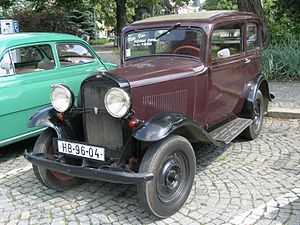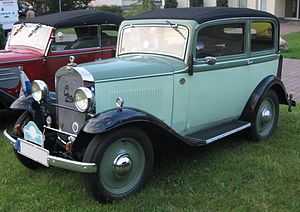Opel 1.2 litre
| Opel 1.2-litre (1931 – 1935) Opel 1.0-litre (1933) Opel P4 (1935 – 1937) | |
|---|---|
|
Opel 1.2-litre Cabrio-Limousine (1932) | |
| Overview | |
| Manufacturer | Adam Opel AG |
| Production |
Opel 1.0-litre 1933 5,600 cars Opel 1.2-litre 1931 - 1935 65,584 cars Opel P4 1935 - 1937 173,027 cars |
| Assembly | Rüsselsheim |
| Body and chassis | |
| Body style | 2-door saloon/sedan, various 2 & 4 seater 2-door cabriolets and other inexpensive open topped configurations |
| Layout | FR layout |
| Powertrain | |
| Engine |
1933: 995 cc side-valve 4-cylinder 4-stroke 1931-35: 1193 cc side-valve 4-cylinder 4-stroke 1935-37: 1073 cc side-valve 4-cylinder 4-stroke |
| Transmission |
1931 – 37: 3-speed manual 1933 – 1937: 4-speed manual No synchromesh |
| Dimensions | |
| Wheelbase | 2,286 mm (90.0 in) |
| Length |
3,215 mm (126.6 in) - 3,500 mm (140 in) |
| Width | 1,425 mm (56.1 in) |
| Height |
1,585 mm (62.4 in) – 1,650 mm (65 in) |
| Chronology | |
| Predecessor | Opel Laubfrosch 4/20 |
| Successor | Opel Kadett |
The Opel 1.2-litre is a small car manufactured by Adam Opel AG between 1931 and 1935. The 1.2-litre was replaced in 1935 by the Opel P4 which was broadly similar but employed a new engine and continued in production till December 1937. For just one year, in 1933, the manufacturer also offered the Opel 1.0-litre which was an Opel 1.2-litre with a smaller engine.[1] The Opel 1.2 litre replaced the last version of the Opel Laubfrosch and was itself first complemented and then effectively replaced by the more roomy Opel Kadett which had itself already entered production in 1935.
Opel was Germany’s top auto-producer throughout the 1930s.[2] Between 1932 and 1936 this model was the manufacturer’s top seller.
Origins
The Opel 1.2-litre entered production in July 1931. Conceptually and technically it closely resembled the Opel 1.8-litre which had been launched six months earlier, the two models even sharing identical cylinder dimensions. However, the 1.8 engine included six cylinders where as the 1.2 came with only four. Control over Opel had been purchased by General Motors in 1928 and the 1.2 model was developed in America, with the need for efficient inexpensive production built into the development process. The wheelbase would be considered a little short for this class of car, but there would be no arguing with the aggressive pricing strategy that Opel were able to pursue with the 1.2-litre.[3]
New naming conventions
Opel naming conventions had hitherto followed the normal German practice of giving each model a two number name in which the first number represented the car’s tax horsepower and the second number represented its actual (metric) horse power. The car’s predecessor had been sold as the Opel 4 / 20 because its tax horsepower would have been 4 and its "actual" horsepower 20 PS (15 kW; 20 hp)[note 1] The Opel 1.2 was an early example of a new naming convention whereby the car was simply named according to the engine size in cc, rounded to the nearest 100cc and then divided by 1,000. Although Opel themselves would not always follow this convention faithfully, it was nevertheless a naming convention which became popular with auto-makers in several European countries in the ensuing decades as “Tax horsepower”, differently calculated in each country, became ever less relevant and less widely understood.


The engine and running gear
The 1193cc side-valve engine delivered a claimed maximum output of 22 PS (16 kW; 22 hp) which in 1933 increased a little to 23 PS (17 kW; 23 hp). published top speed was 85 km/h (53 mph), and in the case of the slightly heavier “Regent” bodied version 82 km/h (51 mph). Transmission of power to the rear wheels took place via a three speed manual gearbox without synchromesh. From 1933 a four speed option became available, although the three speed transmission continued to be the standard offering on the lower specification cars throughout. The brakes were controlled via a cable linkage and at this stage operated on the drive shaft.[4]
Moving downmarket
For 1933 Opel introduced the Opel 1.0-litre which was a simplified version of the 1.2-litre power by a 995cc engine. Claimed maximum power for this version of the car was 18 PS (13 kW; 18 hp) and top speed was down to 78 km/h Production commenced in November 1932, but only one car was sold before the end of the year. However, by the time production ended after just one year in November 1933 5,600 of the reduced specification cars had been produced. Ending production of the 1.0-litre after just one year has been attributed to the economic recovery which was finally setting in, with the total size of the German car market increasing from 41,118 cars in 1932 to 130,938 in 1934. :[5] Also relevant will have been the abolition in Germany for new cars purchased after 1933 of annual car tax.[6] This tax which would return only in 1945 was based on engine size, and the reduced taxation level attracted by its smaller engine had been one of the key selling features of the Opel 1.0-litre.
A range of bodies
The car was launched with the usual range of bodies. The entry level car was the open-topped two-seater which was priced in 1931 at 2,000 Marks. With price deflation a feature of the economy at this time, it was possible in 1932 to reduce the manufacturer’s listed price to 1,890 Marks. There were two and four-seater cabriolets which came with a foldaway roof-cover and there was a two-door four-seater “Limousine” (sedan/saloon) retailing for 2,700 Marks in 1931: by 1935,following a more general upgrade for the model in 1934, the price for two door four seater “Limousine” was down to 1,850 Marks, presumably helped by economies of scale resulting from the car’s popularity.
Expanding the range upmarket
In 1932 the 1.2-litre Regent took the range upmarket. This took the two-door “Limousine” (sedan/saloon) body of the larger Opel 1.8 and persuaded it onto a slightly extended version of the smaller platform of the 1.2-litre.
4-door “Limousine” (sedan/saloon) bodies became available in 1933 both for 1.2-litre car, featuring a “six-light” body and a lengthened 2,445 mm (96.3 in) wheelbase.[7] The car was nevertheless still short for a four door design and the doors were narrow.[8]
1934 range rationalistion
1934 saw a simplification of the range of available body types, which was now reduced to three. These were a “Limousine”, a “Special-Limousine” and a “Cabrio-Limousine” with a “roll-back soft top”. The removal, after just a year in production, of the four door “Limousine” reflected the introduction in January 1934 of the slightly larger Opel 1.3 which from the start came with the option of a four door “Limousine” (sedan/saloon) body.[9]
1935 Opel P4
In September 1935 the Opel P4 replaced the Opel 1.2-litre. The body was unchanged apart from an updated front grill. Also unchanged were the wheelbase and the transmission. What was new was the engine, which was less “undersquare” than before, though its essential architecture as a four cylinder in-line side-valve unit was familiar enough. The claimed maximum power output and top speed were unchanged at 23 PS (17 kW; 23 hp) and 85 km/h (53 mph) respectively. What did change was the engine size, now reduced to 1073cc. In view of the price reduction from 1,850 Marks to 1,650 Marks which accompanied the change to the P4 model, and the further reduction to 1,450 Marks in 1937, it seems likely that the new power unit was cheaper to produce than the earlier power-plant.[10]
This was also the point at which four wheel brakes replaced the earlier braking system which had operated on the drive shaft.[11]
Despite the unchanged performance, in the marketplace the reduced engine size would have distanced the car from the more modern Opel 1.3-litre introduced in 1934, and from the manufacturer's important new Olympia and Kadett models which entered production respectively in 1935 and late 1936.
Commercial
Commercially the car was a success. Possibly on account of the aggressive price reduction accompanying its introduction the P4 sold even better that the 1.2-litre model, with 40,405 cars produced in 1936 which was the models best year,[12] and the year in which its production volume equated to 19% of the German passenger car market.[13] In view of the relatively national focus of the major individual European automobile markets at this time, the overwhelming majority of Opel 1.2-litre/P4 models will have been sold in Germany. In 1936 the Opel P4 was Germany’s most popular car. The value for money that the Opel P4 offered will have been a cause for concern to supporters of the government sponsored Volkswagen programme which was already well advanced and which was a pet project of Adolf Hitler. Production of the little Opel was in any case much reduced during 1937, the P4’s last year of production, reflecting the popularity of the larger and much more modern Kadett: for the Kadett 1937 was the first full year of production.[14]
Total production between 1931 and 1937 of the 1.2-litre, 1.0-litre and P4 models together was 173,027.
Notes
|
- ↑ A complicating factor here is that the German Finance Office had abolished the concept of Tax Horsepower (Steuer-PS) in 1928 and replaced it with Tax engine capacity (Steuer ccm). However, for several years after 1928 it is clear that the auto-business continued for some purposes to think in terms of tax horse-power.
Sources and further reading
- Oswald, Werner (2001). Deutsche Autos 1920-1945, Band (vol) 2 (in German). Motorbuch Verlag. ISBN 3-613-02170-6.
This entry includes information from the equivalent entry in the German Wikipedia
| ||||||||||||||||||||||||||||||||||||||||||||||||||||
| Opel car timeline, 1919–1950 next » | |||||||||||||||||||||||||||||||||
|---|---|---|---|---|---|---|---|---|---|---|---|---|---|---|---|---|---|---|---|---|---|---|---|---|---|---|---|---|---|---|---|---|---|
| Type | 1919 | 1920s | 1930s | 1940s | 1950s | ||||||||||||||||||||||||||||
| 9 | 0 | 1 | 2 | 3 | 4 | 5 | 6 | 7 | 8 | 9 | 0 | 1 | 2 | 3 | 4 | 5 | 6 | 7 | 8 | 9 | 0 | 1 | 2 | 3 | 4 | 5 | 6 | 7 | 8 | 9 | 0 | ||
| Small family car | 4/12 PS | 1.2 litre / P4 | |||||||||||||||||||||||||||||||
| 4/14 PS | 4/16 PS | 4/20 PS | 1.0 litre | 1.3 litre | Kadett | ||||||||||||||||||||||||||||
| Compact car | Olympia | Olympia | |||||||||||||||||||||||||||||||
| Large family car | 7/34 & 8/40 | 1.8 litre | 2.0 litre | ||||||||||||||||||||||||||||||
| Executive car | 10/40 | Super 6 | Kapitän | Kapitän | |||||||||||||||||||||||||||||
| Luxury Car | 12/50 | 14/50 | |||||||||||||||||||||||||||||||
| Regent | Admiral | ||||||||||||||||||||||||||||||||
